We are living in the era of the ‘Evolved Consumer,’ where consumers actively seek information to make informed decisions and don’t place their trust implicitly in brands. User Behavior today is heavily reliant on reviews, user-generated content & influencers.
So, how do you make your brand stand out and get noticed? By providing highly targeted, customized, and hyper-personalized experiences. That is what Hyper-Personalization is all about.
What is Hyper-Personalization and why is it important for Business?
Hyper-personalization is a more advanced next step to personalized marketing where it leverages artificial intelligence (AI) and real-time data to supply more relevant content, product, and service information to every user.
Hyper personalization in marketing allows businesses to create a customer experience that feels tailor-made. When customers feel understood and valued, they are more likely to engage with the brand, leading to higher satisfaction and loyalty.
Additionally, hyper-personalized experiences are more effective at guiding customers through the buying process. By presenting the right message at the right time, businesses can see an increase in conversions and sales.
In this blog, we will learn how brands like Amazon, Netflix, Spotify, & Sephora are fully embracing hyper-personalization. Also, find industry-specific data points that can be used to create effective hyper-personalized campaigns for your business.
Table of Contents:
- What is the difference between Personalization & Hyper-Personalization?
- The need for Hyper-Personalization
- How Hyper-Personalization Can Help Reduce Marketing Costs in the Long Run
- How brands are using Hyper-Personalization
- Amazon
- Netflix
- Starbucks
- Spotify
- How can you start off with Hyper-Personalization?
Regular Personalization vs Hyper-Personalization?
Conventional personalization often involves using basic customer data like names, purchase history, and location. This approach may include general tactics like sending an email with a customer’s name and recommending products related to previous purchases. However, it lacks the depth and individual focus of hyper-personalization.
On the other hand, hyper-personalization goes one step further and utilizes behavioral and real-time data to create highly contextual communication relevant to the user.
Hyper-personalization is more advanced. Here, the aim is not only to recognize the customer but to anticipate their needs and preferences, often before they do.
For example, a user browses for green shoes on your app, spends around 15 mins, and leaves without purchasing. A quick analysis of the user reveals:
- An affinity for buying discounted goods
- Prior search and purchase history for ‘X’ footwear brand
- Maximum purchases happening on a Sunday from 6-9 PM in the night
- Push notifications having the highest user engagement in the past
Now, a hyper-personalized campaign would send a push notification to the user’s mobile device advertising a flash sale on X brand’s green shoes on a Sunday, preferably between 6-9 PM.
While regular personalization makes the customer feel acknowledged, hyper-personalization makes them feel truly understood. This deeper level of relevance can significantly enhance customer engagement.
Drive app engagement to new heights with WebEngage’s mobile push notification tools.
The need for Hyper-Personalization
- Your message only has 8 seconds to capture and hold the attention of your user. To get noticed, your communication needs to stand out and be clutter-breaking.
- According to Google, ‘best’ search phrases have increased by 80% in the past 2 years on mobile devices. People are searching online heavily to make more informed decisions.
- User engagement with content has gone down by 60%, and information overload is making consumers tune out.
- According to Mckinsey, 76% of consumers will be more likely to purchase from someone whose offerings are personalized according to individual preferences.
How Hyper-Personalization Can Help Reduce Marketing Costs in the Long Run
Hyper-personalization is an advanced marketing strategy that significantly impacts how businesses engage with their customers and manage marketing costs. Utilizing data, analytics, AI, and automation, hyper-personalization delivers highly customized experiences for each customer.
One of the primary benefits of hyper personalization in marketing is the ability to reduce acquisition costs significantly. By tailoring marketing efforts to meet individual customers’ specific needs and preferences, businesses can cut down on the resources spent on broad, less effective campaigns. McKinsey reports that personalization can reduce acquisition costs by as much as 50%, lift revenues by 5 to 15%, and increase the efficiency of hyper personalized marketing spend by 10 to 30%.
Additionally, hyper personalization in marketing allows for the creation of marketing messages and offers that are more likely to resonate with customers. This tailored approach leads to improved engagement, as customers are more likely to respond to content that aligns with their interests and needs. Consequently, this targeted engagement can lead to higher conversion rates and increased customer loyalty, thereby optimizing the return on investment for hyper personalized marketing efforts.
In the long run, as businesses continue to gather and analyze more data, their hyper-personalization strategies become increasingly accurate and effective. This ongoing refinement leads to a more efficient use of marketing resources, with businesses able to allocate their budgets more effectively towards campaigns and initiatives that are proven to resonate with their target audiences.
How brands are using Hyper-Personalization
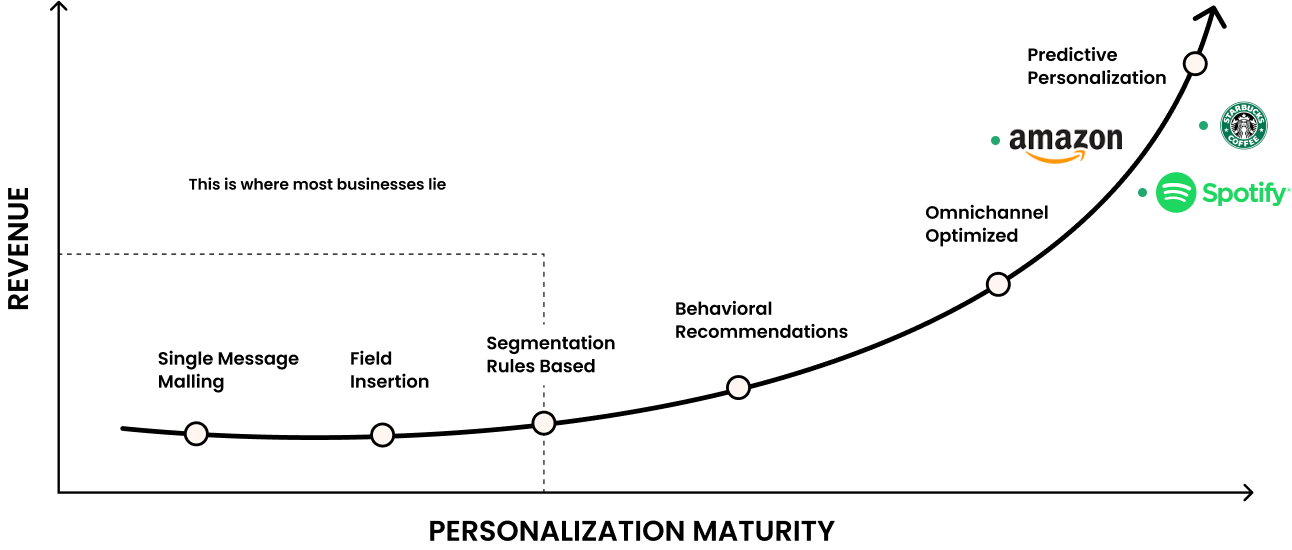
Top brands like Amazon, Spotify & Starbucks have moved on to a stage of predictive personalization, where AI & machine learning analyze a whole host of factors to power their recommendation engine. By and large, most businesses that are dabbling with personalization generally don’t venture beyond segmentation.
Let us take a look at how some of the biggest names in business have achieved incredible growth trajectories with hyper-personalization.
Brand: Amazon
Channel: Email
Amazon is the king of ‘Me-Commerce’, with their recommendation engine powering 35% of conversions. Let us see how Amazon creates a unique, hyper-personalized experience for consumers:
I was scouring Amazon for Olive green running shoes but happened to leave my search mid-way. Soon after, Amazon sent this email:
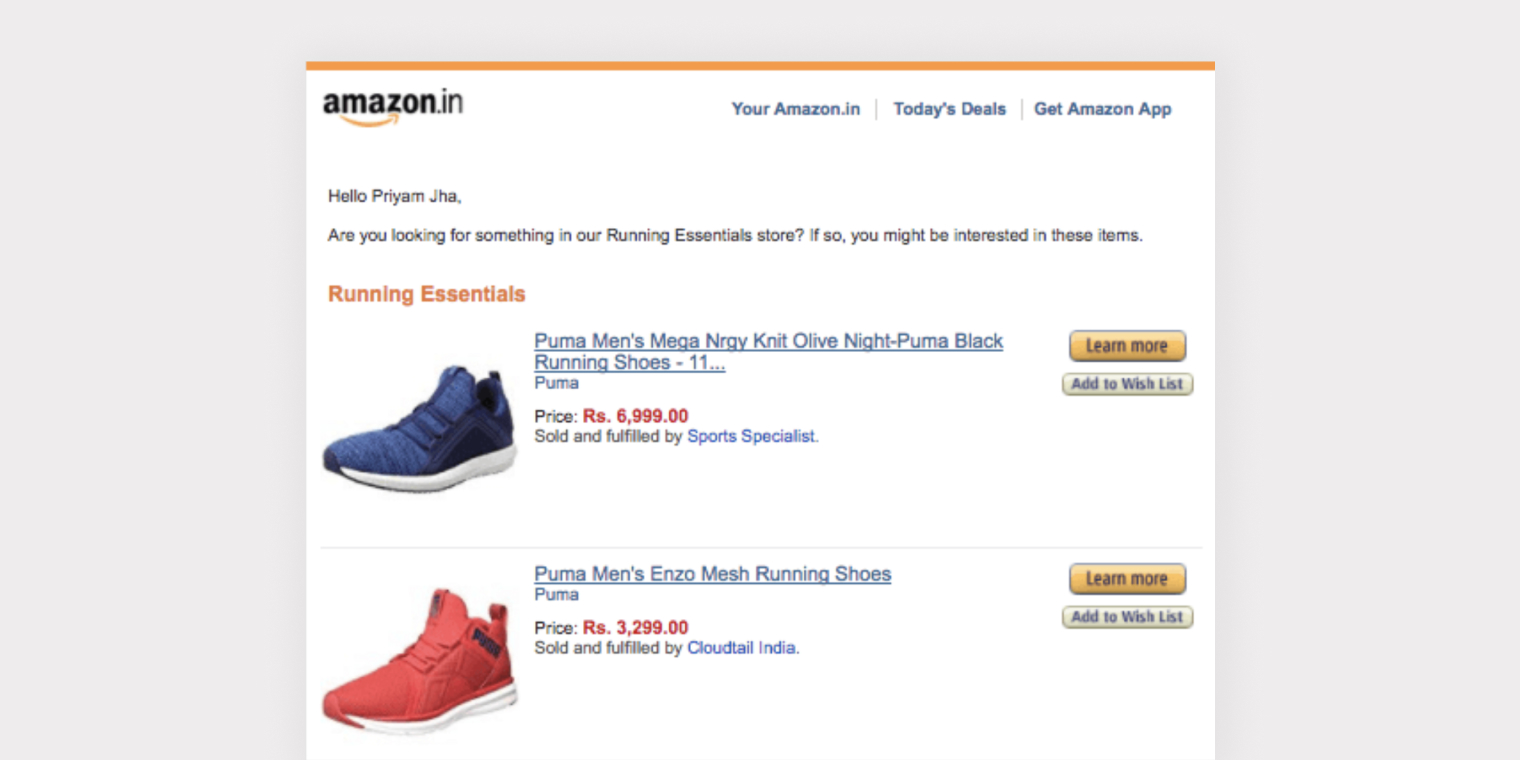
The email goes one step beyond the regular personalization tactic of including my name.
Breakdown:
Amazon has access to data points like Full name, Search Query, Average time spent on search, Past purchase history, Brand affinity, Category browsing habits, Time of past purchases, average spend amount, etc. Using this, they could create a profile and use that to craft a highly contextual email highlighting Olive green Puma shoes (Olive green was part of my search query & I have purchased Puma footwear in the past).
Amazon’s recommendation engine algorithm is called ‘item-to-item collaborative filtering’. It suggests products based on 4 data points:
- Your previous purchase history
- The items that you have in your shopping cart
- Items that you have rated and liked
- Items that have been liked and purchased by other customers
Compared to other E-Commerce brands, conversions from Amazon’s on-site recommendations are 60% higher.
Brand: Netflix
Channel: Digital Platform
Streaming behemoth Netflix boasts of over 247.2 million on its platform. This incredible success is largely because of providing their users a highly personalized experience. More than 75 percent of site activity is driven by their personalization engine. With Netflix, the personalization begins right from the homepage.
Breakdown:
Netflix’s hyper-personalization strategy is displayed by its Netflix Recommendation Engine (NRE). This sophisticated algorithm processes over 3,000 titles using 1,300 recommendation clusters to cater to each user’s unique preferences. The NRE tailors content suggestions for each user, ensuring relevancy and enhancing viewer engagement.

Result:
- Approximately 80% of what viewers watch on Netflix is influenced by these personalized recommendations.
- The precision of NRE not only boosts viewer satisfaction but also reportedly saves Netflix over $1 billion annually.
Brand: Spotify
Channel: Digital Campaign
Spotify has redefined marketing personalization through its “Wrapped” campaign, which leverages customer behavioral data to create unique, engaging experiences. This campaign, launched annually since 2016, has become a social media sensation, showcasing users’ top songs, total listening minutes, and favorite genres in a shareable video format.
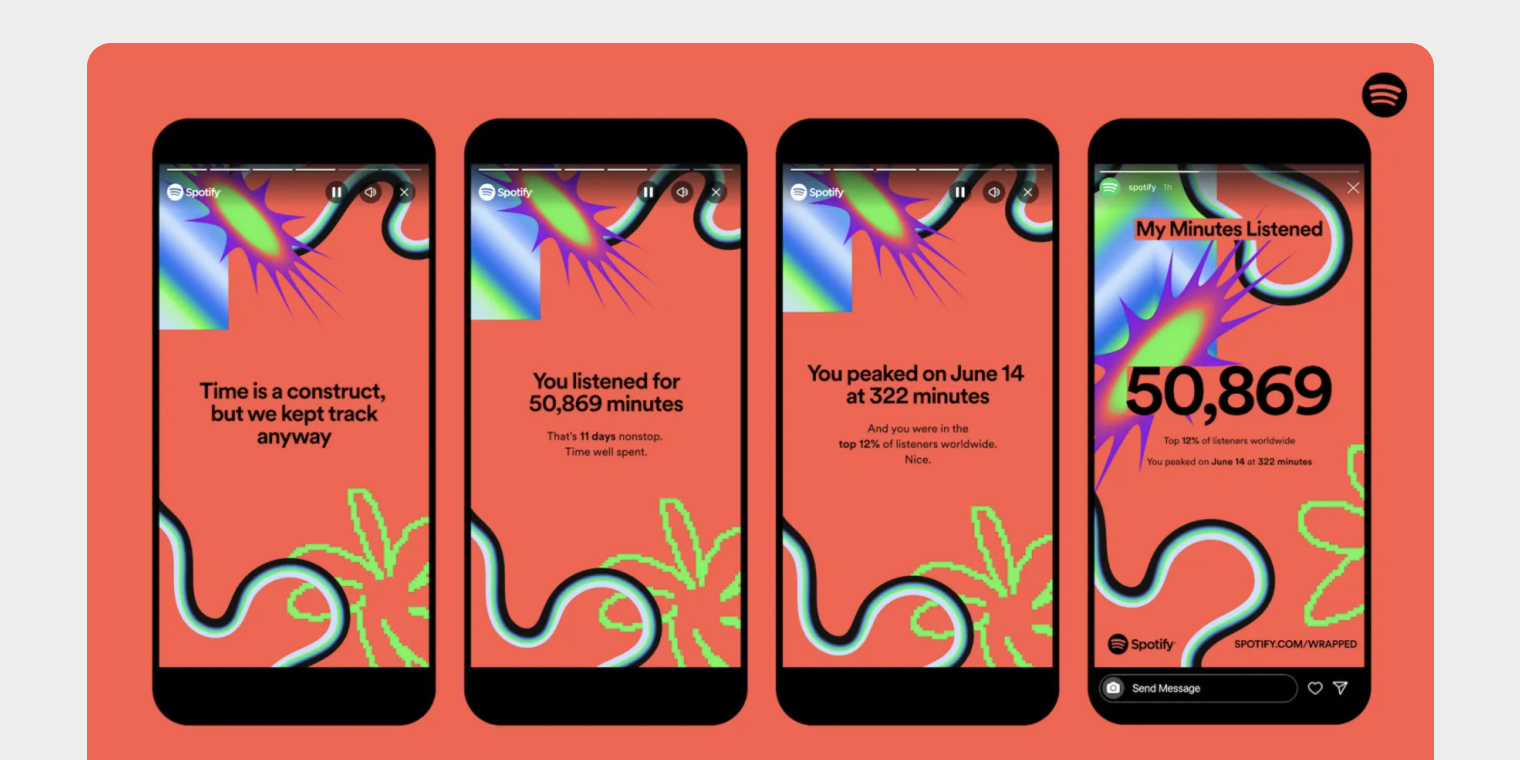
- The Wrapped campaign encourages users to share their music preferences on social media, creating a viral effect.
- Spotify provides detailed insights into users’ listening habits, enhancing user engagement and drawing new app downloads.
- Spotify utilizes AI and ML for playlist curation and music recommendation, tailoring experiences to individual tastes.
How Spotify created FOMO with other users:

Result:
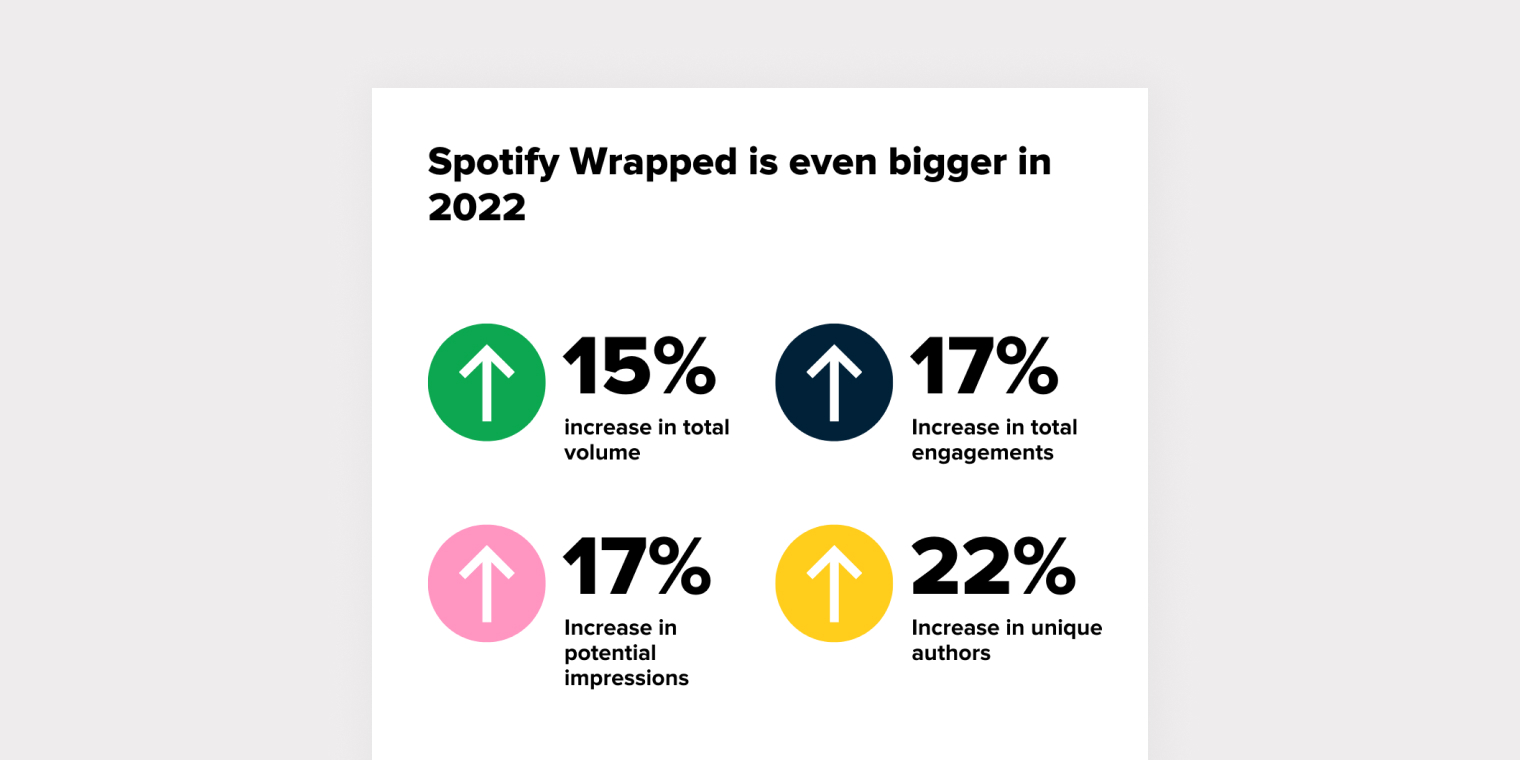
Additionally, the campaign has significantly boosted Spotify’s app downloads and engagement, particularly evident with a 21% surge in mobile app downloads.
Brand: Sephora
Channel: Mobile app & omnichannel strategy
Sephora, an industry leader in beauty retail, has mastered the art of hyper-personalization in its marketing efforts. In 2019, the brand achieved a remarkable revenue increase, reaching $6 billion, up from $4 billion just five years prior.
This success is attributed to several key strategies:
- Sephora’s Visual Artist feature in the app uses augmented reality and AI for virtual product trials, enhancing the online shopping experience.
- The app sends personalized notifications based on user searches and preferences.
- A strong community presence where users engage in discussions, share experiences, and connect.

How it works:

Results:
- Significant revenue growth and market share increase.
- Enhanced customer engagement and loyalty through hyper-personalized experiences.
- Effective utilization of data and technology in both online and in-store environments.
Revolutionize your customer experience with WebEngage’s Omnichannel Engagement tools.
How can you start off with Hyper-Personalization?
Every customer-facing business invariably collects data about users at multiple points. We list down some common data points for different industries that you can use to get started.
- E-commerce
- Online Streaming
- Hospitality
- Fintech
- Travel



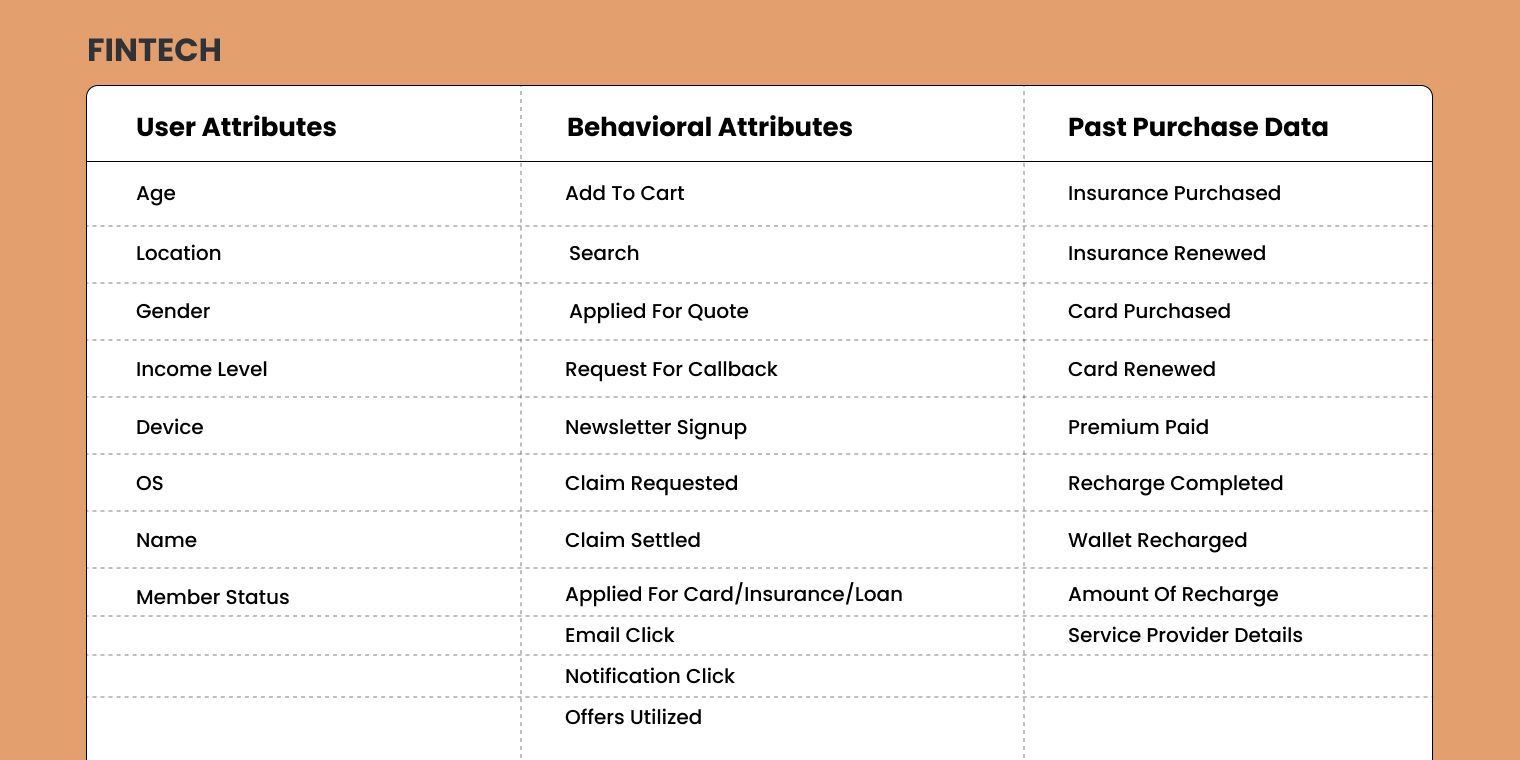

You can identify events that will act as triggers to execute campaigns with customized content. Let’s consider an example from the E-Commerce industry:
- Trigger: Abandoned Cart (User adds product to cart, doesn’t proceed with purchase)
- User attribute: Name, Premium Membership Status, Preferred Message Medium
- Behavior attribute: Product Viewed
- Past purchase data: Discount Coupon Applied, Device used for purchase, Favored Purchase Day
Using WebEngage’s marketing cloud platform, you can create a personalized message (personalization tokens based on data) advertising a discount on the product that was viewed + added to cart (if the user has used a discount coupon in the past). The message can be sent to the device used for purchasing in the past, and an additional offer of faster delivery can be pushed if the user is a premium member (think Amazon Prime account holder). Using historical data analysis, you can also find out which channel of communication had the maximum engagement in the past and employ that in your campaign. By checking the user’s purchase data, the campaign can be sent on a particular day of the week that has yielded good results in the past. That is a properly hyper-personalized campaign.
Summing it up
Brands are jostling in the “Attention Economy” to capture the only currency that matters, Attention. Hyper personalization in marketing can help your brand stand out and increase engagement and conversions with your target audience.
Measure your mobile marketing efforts and boost your hyper-personalization efforts with WebEngage. Book a demo today!
FAQs
What is an example of hyper-personalization?
Imagine you are using a platform for online learning. A standard personalized experience might involve the platform suggesting courses based on your selected interests or past courses you’ve enrolled in. This is helpful, but it’s a broad approach, often relying on static data and general user profiles.
Hyper-personalization takes this a step further. It’s like the platform not only knows the courses you like but also understands:
- Your learning pace
- Preferred content types (like videos over text)
- The time of day you’re most likely to study
- Specific areas within a course where you might need extra help
Based on this rich, real-time data, the platform dynamically adjusts its recommendations – maybe it suggests a short, engaging video tutorial right when you’re most likely to take a break from work, or it offers an in-depth article over the weekend when you have more time to delve deeper.
This level of customization enhances the user experience, increases engagement, and often leads to better customer loyalty and conversion rates.
What is the use of hyper-personalization?
Hyper personalization in marketing is a game-changer in the world of marketing, transforming how businesses interact with their customers. It’s all about delivering experiences that are tailor-made for each individual, using advanced data analysis and real-time information.
Hyper-personalization can significantly enhance the return on investment (ROI) for marketing. Deloitte reports that hyper-personalization can deliver an ROI of up to 80%.
It also plays a crucial role in managing the customer experience. It allows brands to create authentic, relevant interactions, leading to personalized care and empowering customers along their buyer’s journey.
Hyper personalized marketing fosters emotional engagement with customers, thereby increasing brand loyalty. Satisfied customers are more likely to recommend the brand to others, further enhancing its reach and reputation.
What are the challenges of hyper-personalization?
While hyper-personalization is a powerful tool in marketing, implementing it comes with its own set of challenges.
- To personalize effectively, businesses need access to a lot of data. This includes browsing history, purchase records, and even personal preferences. Balancing the collection of such detailed information with respecting customer privacy is a delicate task.
- Having a lot of data is one thing; ensuring it’s accurate and usable is another. Often, data is scattered across various systems and platforms. Integrating this data to form a cohesive, accurate customer profile is a significant challenge.
- Customer preferences and behaviors change. A hyper-personalization strategy that works today might not be effective tomorrow. Continuously updating and adapting strategies to align with evolving customer profiles is a constant challenge.
- There’s a fine line between personalized and invasive. If customers feel like their privacy is being invaded, it can lead to a negative perception of the brand. Striking the right balance between personalization and privacy is crucial.
Is hyper-personalization good or bad?
The question of whether hyper-personalization is good or bad isn’t straightforward, as it comes with both significant benefits and notable concerns.
Pros:
- Hyper-personalization tailors experience to individual preferences, leading to a more satisfying and relevant customer journey.
- For businesses, hyper-personalization often translates to higher engagement rates, improved customer loyalty, and increased sales.
- This approach allows businesses to gain deeper insights into customer behaviors and preferences, enabling them to refine their products and services.
Cons:
- The biggest challenge is balancing personalization with privacy. Collecting and using vast amounts of personal data can raise concerns among customers, especially if they feel their privacy is being compromised.
- Over-personalization or inaccurate personalization can lead to customer irritation. If customers feel bombarded with too many personalized messages, or if the messages miss the mark, it can have a negative impact.
- Implementing hyper-personalization effectively requires significant resources, including advanced technology and skilled personnel.







 Dev Iyer
Dev Iyer
 Prakhya Nair
Prakhya Nair
 Vanhishikha Bhargava
Vanhishikha Bhargava
 Diksha Dwivedi
Diksha Dwivedi
